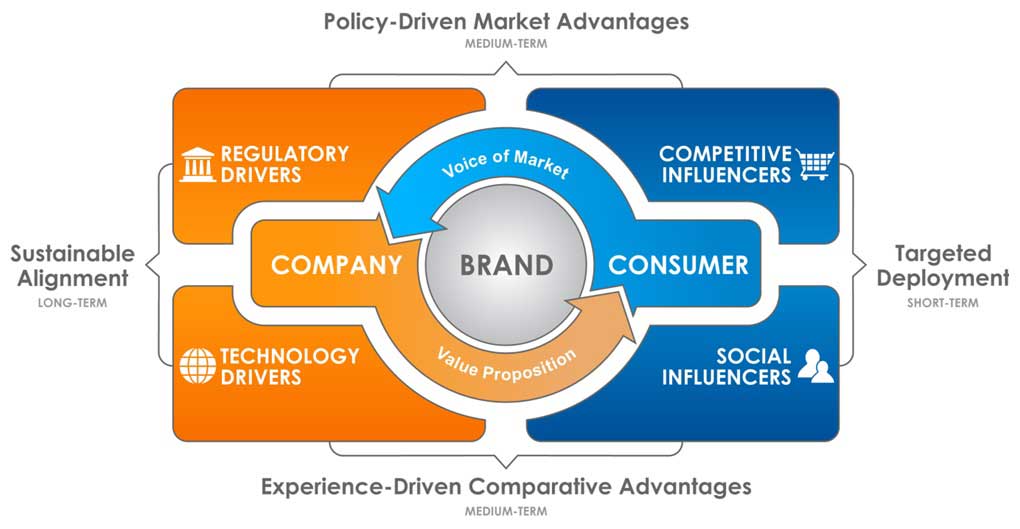No question about it, brand loyalty is down since the recession. To fight that trend, marketers have been taking the traditional route of using short-term tactics. They've lowered prices, instituted or expanded rewards programs, and spent more on advertising. However, those are expensive, and when everyone is using the same tactics, their effectiveness is minimized.
Something different is needed: a contextual marketing strategy to build brand loyalty.
A contextual marketing strategy harnesses industry and market drivers, as well as external forces of influence ("influencers"). The drivers determine market direction and what it takes to stay competitive; influencers shape the voice of the market.
Here is how those forces break down:
- Regulatory drivers have long- and medium-term impact. Government regulations are an example. Marketers must understand how the "rules" of their industry are changing and they must stay ahead of policies when developing long- and medium-term strategies.
- Technology drivers also have long- and medium-term impacts. These drivers are the technological advancements that will influence the way products will be built, distributed, communicated, consumed, or serviced within an industry.
- Social influencers have medium- and short-term impacts. Social influencers shape consumer shopping dynamics. They include macroeconomic elements, behavioral patterns, and social trends that influence buying decisions.
- Competitive influencers also have medium and short-term impacts. Competitive influencers are the factors that shape consumer demand. They are a brand's competitors, including both the direct and indirect (substitute) products and services.
Understanding and harnessing those drivers gives you four powerful ways to build brand loyalty. They deliver everything from short-term tactics to long-term strategies.
This article series will outline how you can create...
- A long-term sustainable alignment for your business
- Medium-term policy-driven market advantages
- Medium-term experience-driven competitive advantages
- A short-term targeted deployment
The first two capitalize on the drivers; that's where we'll begin in the first part of this series. In the second part we'll cover the last two items on that list.
How to Create Sustainable Alignment
Sustainable alignment is how well your company's product or service aligns with its industry's technology and regulatory drivers. Although you must achieve such alignment while you're developing your product or service, the competitive advantage you enjoy can be long-term.
Think "big picture" here, starting with how to create sustainable alignment across your industry's value chain. Understand how the "rules" of your industry are changing and how technology is evolving in R&D, manufacturing, sales/marketing, distribution, and service.
Creating a long-term sustainable advantage consists of three critical components. The first is to establish a clear vision; from that vision come two other tactics—sustainable delivery platforms and standardization.
- Clarifying your vision. Long-term strategic thinking is not about inventing specific products for the future. It starts by defining what your business actually does. Toyota Motor Corporation's vision, for example, is to "lead the way in the future of mobility...." It's not constraining itself to being just an automotive manufacturer. That kind of vision allows you to think bigger than individual products, strengthening your long-term competitive advantage.
- Sustainable delivery platforms. Not long ago, delivery platforms weren't seen as a competitive advantage for companies. That's no longer true. Apple's success can be attributed to its ability to seamlessly integrate its products in a way that can be easily monetized. Though its hardware products were catalysts in generating demand, the integration of its underlying platform (iOS, iTunes/App store) sustained its competitive advantage and earnings potential. Microsoft is similar. Integrating Microsoft Office and Internet Explorer with Windows gave it huge margins while others in the PC industry had to deal with much smaller margins.
Think about how your industry will be driven by technological advancements and by changes in the ways consumers interact with products. Doing so will help you find the areas in which to compete for the long-term and ways to align your company to accomplish that. - Establishing technology standardization. Understanding the value chain can help you lay the foundation for next-generation products and services. Government regulations can play a big role by determining standards (e.g., EPA mileage requirements). Some standards are set by industry, as with Blu-ray format adoption.
How to Create Policy-driven Market Advantages
Regulations are increasingly prevalent. In its first three years, the Obama administration added more than $46 billion in annual costs to industry due to major regulations, compared with $8.1 billion during the same period of the Bush administration. Consequently, more is being spent on lobbying activities.
Government can have a significant influence on brand loyalty, and marketers must be aware of the medium- to long-term implications of regulatory actions. Regulatory costs are either absorbed or passed on to the customer.
Though some industries are hit hardest by regulations, initiatives like Dodd-Frank, EPA rulings, and healthcare reform hit smaller companies, as well.
Along with a company's government or regulatory affairs group, marketers must identify competitive advantages and disadvantages. Explore the following areas:
- Consumer visibility: regulations that control marketing activities, such as restrictions on advertising content, product labeling, etc. Implications for marketing activities include message development, marketing mix, and packaging. One example is drug companies' being allowed to advertise directly to consumers.
- Consumer accessibility: regulations that change the ability of consumers to buy products or services based on geography, channel, age, etc. Implications for marketing activities include message development and distribution strategy. Interstate liquor laws are an example.
- Consumer affordability: regulations that increase or lower prices. These can include excise taxes, tax credits, tariffs, etc., and they affect product development and pricing. For instance, will certain high-calorie foods be increasingly taxed?
- Consumer usability: regulations that control how consumers use the capabilities of the product or service. These may involve safety restrictions or censorship, and they affect product development. The file-sharing site, Napster, is an example.
Using technology and regulatory drivers to create sustainable alignment and policy-driven market advantages can greatly boost your efforts at building your brand.
In the second (and final) installment in this series we'll see how to create experience-driven competitive advantages and targeted deployment.
Articles in this two-part series:





